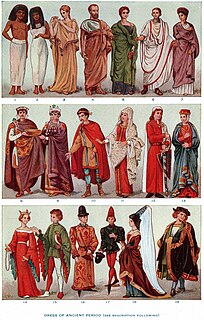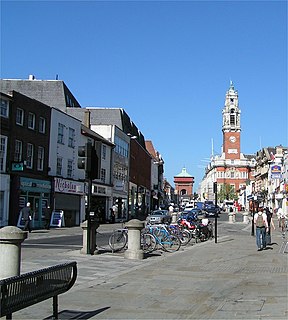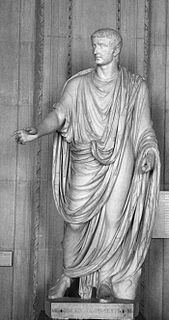Related Research Articles

Clothing is items worn on the body. Clothing is typically made of fabrics or textiles but over time has included garments made from animal skin or other thin sheets of materials put together. The wearing of clothing is mostly restricted to human beings and is a feature of all human societies. The amount and type of clothing worn depends on gender, body type, social, and geographic considerations.

Brown is a composite color. In the CMYK color model used in printing or painting, brown is made by combining red, black, and yellow, or red, yellow, and blue. In the RGB color model used to project colors onto television screens and computer monitors, brown is made by combining red and green, in specific proportions. In painting, brown is generally made by adding black to orange.

A textile is a flexible material consisting of a network of natural or artificial fibers. Yarn is produced by spinning raw fibres of wool, flax, cotton, hemp, or other materials to produce long strands. Textiles are formed by weaving, knitting, crocheting, knotting, tatting, felting, or braiding.

Textile arts are arts and crafts that use plant, animal, or synthetic fibers to construct practical or decorative objects.

Carding is a mechanical process that disentangles, cleans and intermixes fibres to produce a continuous web or sliver suitable for subsequent processing. This is achieved by passing the fibres between differentially moving surfaces covered with card clothing. It breaks up locks and unorganised clumps of fibre and then aligns the individual fibres to be parallel with each other. In preparing wool fibre for spinning, carding is the step that comes after teasing.

Muslin, is a cotton fabric of plain weave. It is made in a wide range of weights from delicate sheers to coarse sheeting. It gets its name from the city of Mosul, Iraq which the Europeans believed to be its place of origin. However, its origins are now thought to have been farther east — in particular Dhaka in Bangladesh.

Colchester is a historic market town and the largest settlement within the borough of Colchester in the county of Essex. Colchester was the first Roman-founded Colonia in Britain, and Colchester lays claim to be regarded as Britain's oldest recorded town. It was for a time the capital of Roman Britain, and is a member of the Most Ancient European Towns Network.

Flannel is a soft woven fabric, of various fineness. Flannel was originally made from carded wool or worsted yarn, but is now often made from either wool, cotton, or synthetic fiber.

Bògòlanfini or bogolan is a handmade Malian cotton fabric traditionally dyed with fermented mud. It has an important place in traditional Malian culture and has, more recently, become a symbol of Malian cultural identity. The cloth is exported worldwide for use in fashion, fine art and decoration.
Longcloth refers to a plain cotton cloth originally made in comparatively long pieces.
The United States Army in World War II used a variety of standard and non-standard dress and battle uniforms, which often changed depending upon the theater of war, climatic environment, and supply exigencies.
Russet is a dark brown color with a reddish-orange tinge. As a tertiary color, russet is an equal mix of orange and purple pigments.

The study of the history of clothing and textiles traces the development, use, and availability of clothing and textiles over human history. Clothing and textiles reflect the materials and technologies available in different civilizations at different times. The variety and distribution of clothing and textiles within a society reveal social customs and culture.

Clothing in ancient Rome generally comprised a short-sleeved or sleeveless, knee-length tunic for men and boys, and a longer, usually sleeved tunic for women and girls. On formal occasions, adult male citizens could wear a woolen toga, draped over their tunic, and married citizen women wore a woolen mantle, known as a palla, over a stola, a simple, long-sleeved, voluminous garment that hung to midstep. Clothing, footwear and accoutrements identified gender, status, rank and social class. This was especially apparent in the distinctive, privileged official dress of magistrates, priesthoods and the military.

The hanfumovement is a social movement seeking to revitalize ancient Han Chinese fashion that developed in China at the beginning of the 21st century.

Samite was a luxurious and heavy silk fabric worn in the Middle Ages, of a twill-type weave, often including gold or silver thread. The word was derived from Old French samit, from medieval Latin samitum, examitum deriving from the Byzantine Greek ἑξάμιτον hexamiton "six threads", usually interpreted as indicating the use of six yarns in the warp. Samite is still used in ecclesiastical robes, vestments, ornamental fabrics, and interior decoration.
Mockado is a woollen pile fabric made in imitation of silk velvet from the mid-sixteenth century. Mockado was usually constructed with a woollen pile on a linen or worsted wool warp and woollen weft, although the ground fabric could be any combination of wool, linen, and silk. Mockado was used for furnishings and carpeting, and also for clothing such as doublets, farthingales, and kirtles.
Shades of brown can be produced by combining red, yellow, and black pigments, or by a combination of orange and black—as can be seen in the color box at right. In the RGB color model used to create all the colors on computer and television screens, brown is made by combining red and green light at different intensities. Brown color names are often not very precise, and some shades, such as beige, can refer to a wide variety of colors, including shades of yellow or red. Browns are usually described as light or dark, reddish, yellowish, or gray-brown. There are no standardized names for shades of brown; the same shade may have different names on different color lists, and sometimes the one name can refer to several very different colors. The X11 color list of web colors lists seventeen different shades of brown, but the complete list of browns is much longer.

Ancient Chinese clothing or Hanfu refers to the historical clothing styles of China. The Han Chinese historically wore a robe or a shirt for the upper garment, while the lower garment was commonly a pleated skirt. Since the Han dynasty, Chinese clothing had developed varied styles and exquisite textile techniques, particularly on silk, and absorbed favorable elements in foreign cultures. Ancient Chinese clothing was also influential to other traditional East Asian clothing such as the Japanese wafuku and Korean hanbok, as well as traditional Southeast Asian clothing such as the Vietnamese Áo giao lĩnh.
Byrd Cloth is a type of fabric similar to Grenfell Cloth which was designed in the 1934 by Harris Thurston and heavily promoted by Antarctic explorer Richard Byrd. The material was considered windproof, yet the weave allowed some air to penetrate and therefore allowed sweat to evaporate from the body rather than freeze against the skin. It was meant to replace the fur-lined parkas which had traditionally been used for cold-weather exploration, and was discovered to also be ideal for World War II army uniforms because it absorbed less sweat, repelled mosquito bites, and was much lighter weight than the existing cotton twill uniforms worn by soldiers in the Pacific theater of the war.
References
- 1 2 3 St. Clair, Kassia (2016). The Secret Lives of Colour. London: John Murray. p. 246-247. ISBN 9781473630819. OCLC 936144129.
- ↑ R. H. Britnell (1986), Growth and decline in Colchester, 1300–1525 , Cambridge University Press, pp. 55–77, ISBN 978-0-521-30572-3
- ↑ Ann Rosalind Jones, Peter Stallybrass (2000), "(In)alienable possessions: Griselda, clothing and the exchange of women", Renaissance clothing and the materials of memory, Cambridge University Press, p. 230